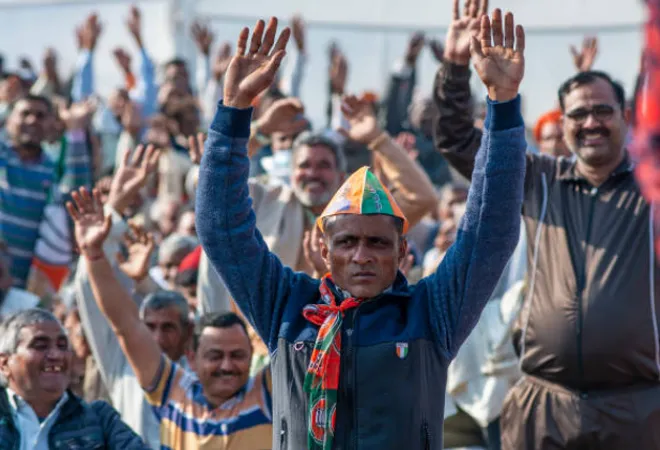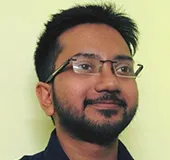-
CENTRES
Progammes & Centres
Location
The upcoming elections in UP reinforces the centrality of identity politics as parties continue to employ community outreach strategies

While five states are going to polls in the coming weeks, it is Uttar Pradesh (UP) which continues to generate the maximum eyeballs for obvious reasons. With 80 Lok Sabha seats, all roads to Delhi go via Lucknow. The ruling Bharatiya Janata Party (BJP) had pulled up impressive electoral victories in the last two general elections (2014 and 2019) and the 2017 Assembly elections in the state. The BJP’s outstanding political success is largely attributed to the effective ‘social engineering’ that it has crafted by forming a broad-based caste coalition of upper castes, non-Yadav Other Backward Castes (OBCs), and non-Jatav Scheduled Castes (SCs).
The last few weeks saw the exit of prominent ministers like Swami Prasad Maurya, Dara Singh Chauhan, Dharam Singh Saini, and other legislators from the BJP who belong to the OBC community, which constitutes as much as roughly 39-40 percent of the state’s electorate.
The saffron party, which was politically dwindling after its brief success in the 1990s, emerged as a formidable force in UP since 2014 with a broadened support base that came along with Prime Minister Modi’s popularity. The BJP’s re-emergence had relegated UP’s other major political forces, like the Samajwadi Party (SP) and Bahujan Samajwadi Party (BSP), to the margins of the state’s electoral landscape, despite their holding on to their core support bases, which is the support of the Yadavs, Muslims, and Jatavs. The Congress, with a marginal vote share, has eroded its political space over the years in the state. However, the last few weeks saw the exit of prominent ministers like Swami Prasad Maurya, Dara Singh Chauhan, Dharam Singh Saini, and other legislators from the BJP who belong to the OBC community, which constitutes as much as roughly 39-40 percent of the state’s electorate. Interestingly, such identity politics is inextricably intertwined with access to crucial resources of welfare and development.
UP politics witnessed the rise of the narrative of social justice in the early 1990s, based on the political assertion of backward and marginalised caste groups. This facilitated the rise of parties like SP, which enjoys the support of the Yadav OBC community, and BSP whose influence is strongly entrenched amongst the Dalits, especially the Jatavs. A dominant perception began to arise that while the Yadav and Jatav communities benefitted under the SP and BSP rule to a large extent, other non-dominant OBCs and Dalit were allegedly marginalised, propelling many small castes to float their own parties. Hence, it was possible for the BJP, from 2014 onwards, to mobilise the non-dominant OBCs and non-Jatav SCs by stitching together strategic alliances with such small parties along with direct mobilisation through the compelling electoral planks of Hindutva and development.
On the one hand, it is being viewed by analysts as a manifestation of the disillusionment of the OBC leaders with the ruling BJP and the latter’s failures to keep its broad social coalition in the state intact.
It is in this context that the recent defections—of the notable non-Yadav OBC leaders from the BJP to the Akhilesh Yadav-led SP—have sent ripples across the state’s political spectrum. On the one hand, it is being viewed by analysts as a manifestation of the disillusionment of the OBC leaders with the ruling BJP and the latter’s failures to keep its broad social coalition in the state intact. On the other hand, the OBC leaders defecting from the BJP as well as the BSP are preferring to support the SP in this election. This is seen as the SP’s political consolidation in managing political support beyond the non-Yadav social base by positing itself as more accommodative and inclusive, which boosts its image as a potential challenger to the BJP.
History bears witness to the instrumentality of the non-dominant OBC support base to the victories of the BSP, the SP, and the BJP in 2007, 2012, and 2017 respectively. Reports suggest that the recent defectors from the BJP—particularly Swami, Rajbhar, and Saini—who have strong support bases within their community can impact the electoral dynamics significantly in several constituencies in the upcoming elections. It is being apprehended that the exit of notable OBC leaders from the BJP, alleging discrimination, might create the ‘perception’ to some extent that the ruling party is largely “pro-upper caste”. It is important to note that the BJP governments, both at the Centre as well as in the state, have made some efforts to accord representation to OBC leaders as ministers. But as highlighted by political analyst, Asim Ali, such steps only constitute a ‘descriptive’ form of representation. The narrative of discrimination allegedly meted out by the BJP towards the OBCs can be attributed to the perception that the party failed to accord ‘symbolic’ as well as ‘substantive’ representation or empowerment to the OBC community during its rule. There have been allegations that despite being ministers, the OBC leaders were not given real authority in the administration, which was controlled by the centralised command of the Chief Minister Yogi Adityanath and his ‘coterie’ of bureaucrats. It is also argued that majority of important positions in the local administration was dominated by the upper-castes who often allegedly ignored the OBC ministers and legislators.
The narrative of discrimination allegedly meted out by the BJP towards the OBCs can be attributed to the perception that the party failed to accord ‘symbolic’ as well as ‘substantive’ representation or empowerment to the OBC community during its rule.
Issues like unfulfilled promises of sub-categorisation of reservation; non-implementation of the caste census; and implementing the Economically Weaker Section (EWS) quota, euphemistically seen as a move for the betterment of upper castes, might erode the BJP’s OBC support base. Moreover, privatisation of the education sector, marginal representation of OBCs in teacher recruitment, and high cases of atrocities against backward castes are being seen as likely to aggravate the sense of insecurity, material deprivation, and betrayal amongst OBCs under the BJP rule. Furthermore, agrarian distress; the three farm laws (though repealed afterwards); the UP-government’s ban on cow slaughter and ill-managed cow sheds leading to the increasing problem of stray cattle, who are roaming freely and are destroying crops of mostly small farmers, many of whom are OBCs; can also alienate the community. Apart from the categorical grievances of the OBC community, the pressing broader issues like COVID mismanagement during the second wave, inflation, price rise, and unemployment being raised by the SP can also enhance the odds against the incumbent BJP government. Moreover, Akhilesh Yadav’s outreach to smaller caste-based parties like the Rashtriya Lok Dal (RLD), having the support of Jats in Western UP along with parties like the Suheldev Bhartiya Samaj Party, and Mahan Dal, amongst others, have contributed to a promising ‘rainbow coalition’ of social groups that can benefit the SP in this election.
Though the indications of a possible realignment of the social coalition in the state might shape the political outcomes of this election and beyond, the BJP’s political resilience cannot be undermined. It is notable that despite seven years in office, surveys suggest that PM Modi remains highly popular in the state. The narratives of governance and development has been strongly pitched by the ruling party. The BJP, by reiterating Chief Minister Yogi Adityanath’s projected image as an efficient law and order enforcer in contrast with the alleged law and order crisis under the Yadav dominance when the SP had been in power, is trying to convey its message of efficient governance delivery. Moreover, a slew of welfare measures undertaken by the state government targeting the economically weaker sections which provides free or subsidised amenities like housing, toilets, and healthcare services along with a major food grains distribution scheme during COVID boosts BJP’s popularity.
Plans to establish universities in Azamgarh, Aligarh, and Saharanpur, an Ayush University and a sports university, nine medical colleges in Purvanchal and tourism development initiatives in Ayodhya, Mathura and Varanasi have been undertaken.
Importantly, a major push towards infrastructural development have been initiated by both the Central and state governments in UP. A number of large-scale projects had been undertaken in the last few years, some of which have been inaugurated in recent months by PM Modi and are at different stages of completion. Some of the major projects include the Noida International Airport, AIIMS in Gorakhpur, Kanpur metro project, UP Defence Industrial Corridor, Kushinagar Airport, Fertiliser Plant of Hindustan Urvarak Rasayan Limited and a hi-tech laboratory in ICMR's regional unit Regional Medical Research Centre (RMRC) in BRD Medical College. Also, plans to establish universities in Azamgarh, Aligarh, and Saharanpur, an Ayush University and a sports university, nine medical colleges in Purvanchal and tourism development initiatives in Ayodhya, Mathura and Varanasi have been undertaken. Also, as a major push to road connectivity, expressway construction “to nearly 640 kilometres to the East (Purvanchal) and the South (Bundelkhand)” along with the 594 kilometre long Ganga Expressway have been initiated by the ruling regime. These developmental projects and welfare schemes can facilitate direct mobilisation of the electorate in the BJP’s favour, transcending caste identities.
The BJP’s repeated invocation of the 2013 Muzaffarnagar riots, where it alleges that the SP has a “Muslim appeasement” policy; might polarise the Hindu voters in the BJP’s favour. Also, the high-decibel inauguration of the Kashi-Vishwanath Corridor in Varanasi and the beginning of the Ram Temple construction rekindles the possibility of Hindutva-based mobilisation in the election. As a result, some sections of the OBCs can also be brought into confidence by the BJP, which can minimise the political damage caused by the recent exodus of OBC leaders. Despite the defections, BJP’s own notable OBC leaders and the BJP’s backward castes political allies like the Apna Dal (S) and Nishad Party might hold back some sections of OBC votes for the ruling saffron party.
Hence, the two variants of identity politics intertwined with competing narratives on development seem to dominate UP’s electoral landscape in this election. All eyes remain on the polls to see whether a comeback of Mandal politics under the leadership of Akhilesh Yadav fructifies or the broader appeal of Hindutva, which is carefully mixed with a heavy dose of welfarism and polarisation triumphs to hold onto power for a second consecutive term.
The views expressed above belong to the author(s). ORF research and analyses now available on Telegram! Click here to access our curated content — blogs, longforms and interviews.

Ambar Kumar Ghosh is an Associate Fellow under the Political Reforms and Governance Initiative at ORF Kolkata. His primary areas of research interest include studying ...
Read More +